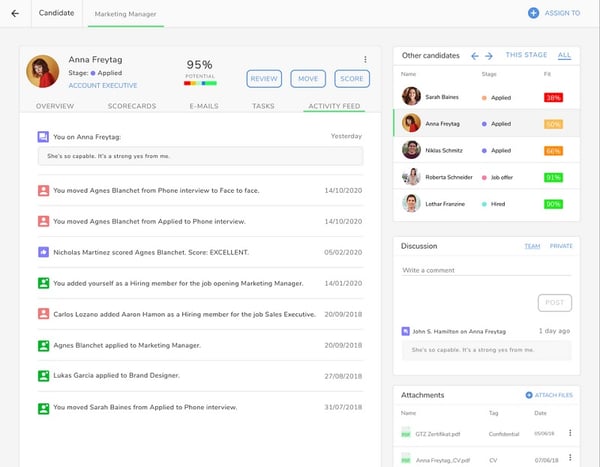So, your company has identified a human resource need. What next? A successful hiring process involves a series of fundamental recruitment steps before new employees can be appointed.
We’ll take a closer look at these below and find out how technology comes into play at each stage of the recruitment process.
The importance of recruitment and staff selection processes
The key to finding quality talent is to recognise the importance of each stage of the recruitment and staff selection process to satisfy an organisation’s HR requirements.
It is therefore crucial to establish a clear recruiting workflow that makes the most of the time available. Every day that goes by without filling a vacancy costs the company money.
Technology is proving to be key to successfully – and quickly – completing all stages of the recruitment process. Current software options allow you to automate tasks and rapidly screen candidates, etc.
Learning Hub has some interesting statistics:
- Every vacancy costs a company $500 per day.
- On average, every job advert receives 250 CVs.
- 98% of Fortune 500 companies use recruitment software.
- 68% of human resources specialists think the best way of improving the recruitment and selection process in the next five years is to invest in technology.

The 8 stages of recruitment and selection
We have already talked about the difference between recruitment and staff selection, but we have not gone into depth about the different steps we need to follow throughout the hiring process.
Here we will explain each one in detail:
1. Identify a need or vacancy within the company
Not all vacancies or personnel requirements that arise are easy to spot. When an employee leaves or moves to a different position without a substitute in place, the company will obviously need to hire a replacement. However, when an organisation grows or changes there may be more work to do or entirely new needs may emerge.
Therefore, the first step of recruiting involves being aware that a personnel need exists within the organisation.
2. Create the job description
Before we start to draft a description of the vacancy, we should identify some key features of the profile we are looking for. For example:
- Are we looking for a professional to take on different roles within the company?
- Should they have extensive sector experience?
- Do they need an impeccable academic record?
All these questions will help build a picture of the company’s needs to craft an effective job description. This should cover the duties and responsibilities involved in the role so candidates can shape their expectations before applying.
3. Decide on your recruitment model
Recruiting involves attracting and engaging talent and can be done in two ways:
- External recruitment: when we look for candidates outside the organisation. For example, on job portals, agencies, etc.
- Internal recruitment: in this case the person who fills the vacancy already works in the company.
Furthermore, if we go down the road of external recruitment, the human resources team can also opt for passive recruitment, where they contact professionals with promising profiles, but who have shown no interest in applying for the post.
 Kenjo Interface
Kenjo Interface
4. Accept and save the CVs
Once the recruitment stage has launched, the human resources team will start to receive applications via the usual channels. These may come with CVs and cover letters, so it is vital to carefully save all these documents.
CRM systems will help you build up your own candidate database. In fact, Kenjo automatically connects with all recruitment portals to save each application on the same platform.
5. Make a shortlist
A large percentage of the applications received will not satisfy the position’s minimum requirements, so an initial screening is usually necessary before the selection process. Interviewing everyone would cost the company significantly in terms of both time and money.
It is much easier to apply filters and obtain a list of the best applicants with the help of recruitment software. With Kenjo you can also perform a quick keyword search and instantly find the professionals you want.
6. Carry out the staff selection process
The goal of the selection stage is to find the best candidate for the vacancy. To do this, we carry out a much more rigorous assessment, to measure, evaluate and compare applicants’ skills and expertise.
Usually, we arrange an individual interview to meet the candidate in person or invite them to participate in a group interview. There are different types of questions you can ask in interviews: ice-breaker questions, questions to get to know the candidate’s character, gauge their problem-solving capabilities, understand their career history, etc.
We can also carry out practical exercises to assess and evaluate aspects that are key for the company. The main staff selection tests include personality tests, knowledge assessments, psychometric tests, etc.
7. Create a report or file for each candidate
Every person that has a say in the choice of final candidate must have the same information. So it is crucial to collate the interview and test results for each candidate.
Ideally, put together a report or overview that gives an at-a-glance view of each candidate’s strengths and weaknesses. If you can also include a general comments section, like Kenjo’s software offers, it will be much simpler to compare them and choose the best.
8. Make the final decision
The final stage of the recruitment and selection process is the all-important decision on which candidate will be joining the company. Take your time to evaluate the different options and make an objective decision about the one who has excelled throughout the process and achieved the best results.
How can technology help in the recruitment process
Traditionally, the manual format of recruitment and selection resulted in a lengthy process that was much more susceptible to decision-making errors.
However, technology has transformed the way companies work, particularly in human resources departments. With recruitment and selection software you can automate tasks, incorporate artificial intelligence assistance, and objectively identify the most suitable candidate for the position.
Moreover, as we saw at the start of this article, there is clear agreement among sector specialists on the importance and value of recruitment software.
.jpeg)

 Kenjo Interface
Kenjo Interface